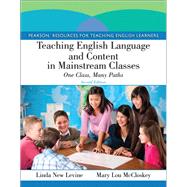
Note: Supplemental materials are not guaranteed with Rental or Used book purchases.
Purchase Benefits
What is included with this book?
Linda New Levine is a consultant for ESL and EFL programs for school-age children. She has assisted in the development of English language programs for successful academic content learning in countries in the Middle East, Africa, and Asia, and for school districts and professional organizations within the U.S. In addition, she works with mainstream classroom teachers for differentiation of teaching and learning in the content areas and for the development of literacy for ELLs in English language classrooms K through 12.
Dr. Levine has worked as an ESL teacher and a staff development facilitator in the Bedford, New York school district, and as an assistant professor at Teachers College, Columbia University.
She has taught EFL in the Philippines with the Peace Corps and in the People’s Republic of China as a Fulbright professor. In addition, she has worked with faculties and ministries of education in Egypt to implement English as a Foreign Language programs in elementary schools throughout the country and to improve the supervisory skills of school supervisors. As part of a design team for USAID, Dr. Levine evaluated language programs in Egypt and designed a format for future funding in that region. She currently consults for the Center for Applied Linguistics.
Dr. Levine was the Homeroom columnist for TESOL’s Essential Teacher and the author of the Teacher’s Edition to the Oxford Picture Dictionary for the Content Areas (2nd Ed.). Her publications include Helping English Language Learners Succeed in Pre-K-Elementary schools (2006) with Jan Lacina and Patience Sowa (TESOL International). Dr. Levine holds a Masters in TESOL and a PhD in Applied Linguistics from New York University.
Mary Lou McCloskey, former President of Teachers of English to Speakers of Other Languages, is Director of Teacher Education and Curriculum Development for Educo in Atlanta. As a consultant and author in the field of English language education, she has worked with teachers, teacher educators, and departments and ministries of education on 5 continents and in 35 of the 50 United States.
Dr. McCloskey has taught in undergraduate and graduate programs at Emory University, Georgia State University, and the University of Memphis. Author and co-author of many journal articles, chapters, and professional texts for educators (including American Themes (2012). Integrating English (1988), Teaching English as a Foreign Language in the Primary School (2006), and Leadership Skills for English Language Educators (2007), she has also developed six programs for English learners, including On Our Way to English (2010); Visions: Language, Literature, Content; Voices in Literature (2008); Teaching Language, Literature and Culture (1995); and was consulting author and ESOL specialist for the 2008 McDougal Littell Language Arts, Grades 5-12 (2008). During the summer, Dr. McCloskey works as a teacher educator in the Teaching Tolerance Through English program conducted for middle school teachers and learners from countries throughout Central Europe by the US Embassies in the region.
Dr. McCloskey, who holds an MS degree from Syracuse University and a PhD from Georgia State University, considers her most important qualification her years of experience with English learners from many cultures, at levels from preschool through graduate education.
Chapter 1 Principles of Integrated Language Teaching and Learning
Chapter 2 Language Acquisition and Language Learning in the Classroom
Chapter 3 Culturally Responsive Instruction: Connecting with Home Culture
Chapter 4 Organizing the Classroom for Language Learning
Chapter 5 Strategies for Oral Language Development
Chapter 6 Oral Language Development in the Content Classroom
Chapter 7 Teaching Vocabulary to English Learners
Chapter 8 Developing Literacy with English Learners: Focus on Reading
Chapter 9 Developing Literacy with English Learners: Focus on Writing
Chapter 10 Structuring and Planning Content-Language Integrated Lessons
Chapter 11 Assessment Tools for the Integrated Classroom
Chapter 12 Putting It All Together Thematically: Developing Content-Based Thematic Units
The New copy of this book will include any supplemental materials advertised. Please check the title of the book to determine if it should include any access cards, study guides, lab manuals, CDs, etc.
The Used, Rental and eBook copies of this book are not guaranteed to include any supplemental materials. Typically, only the book itself is included. This is true even if the title states it includes any access cards, study guides, lab manuals, CDs, etc.